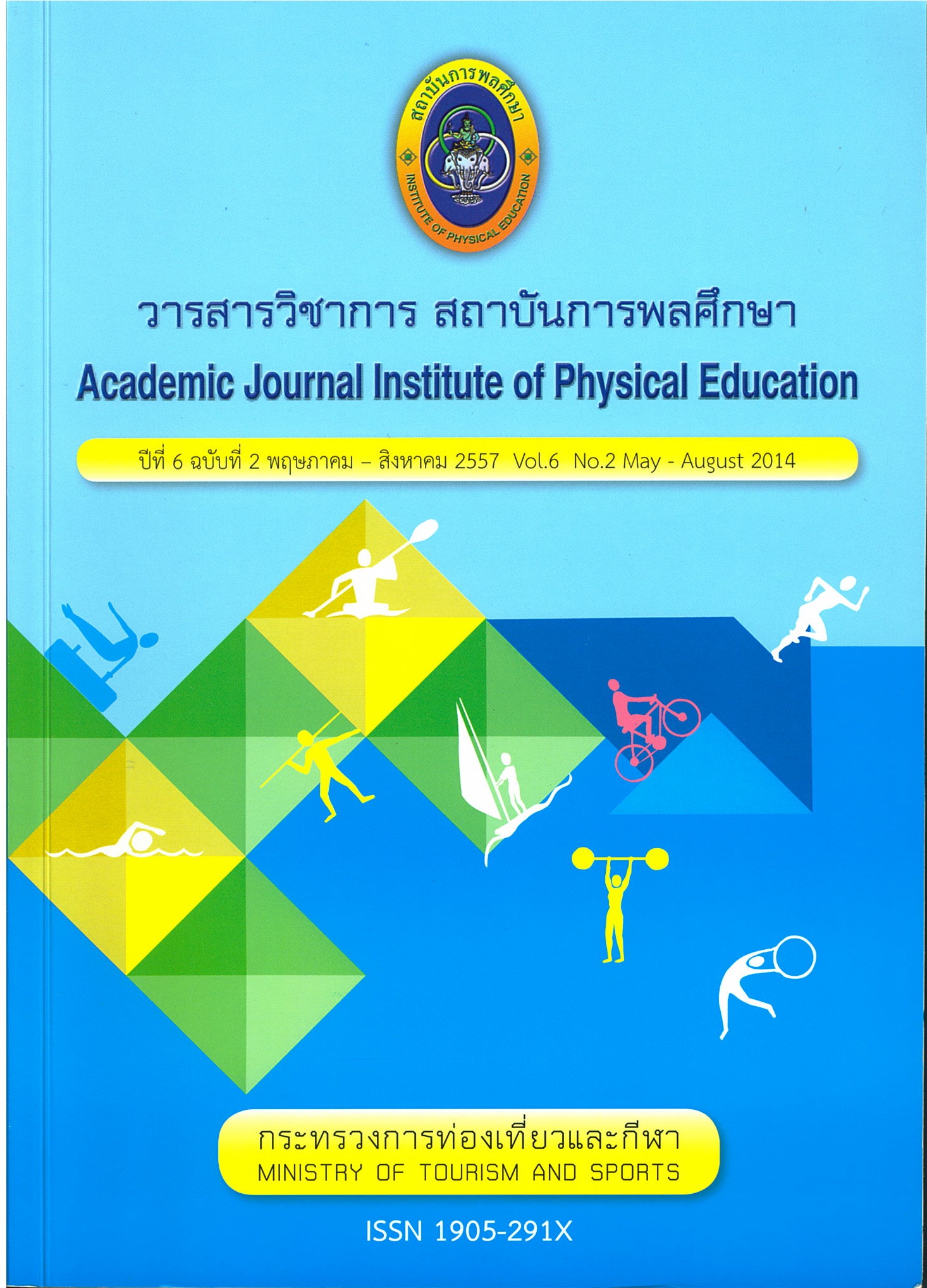รูปแบบการพัฒนานักกีฬามวย สู่นักกีฬามวยสากลสมัครเล่นทีมชาติไทย
Main Article Content
บทคัดย่อ
งานวิจัยเรื่อง รูปแบบการพัฒนานักกีฬามวยสู่นักกีฬามวยสากลสมัครเล่นทีมชาติไทย มีวัตถุประสงค์ เพื่อ 1) ศึกษาองค์ประกอบการพัฒนานักกีฬามวยสู่นักกีฬามวยสากลสมัครเล่นทีมชาติไทย 2) สร้าง รูปแบบการพัฒนานักกีฬามวยสู่นักกีฬามวยสากลสมัครเล่นทีมชาติไทย และ 3) ทดสอบรูปแบบการพัฒนา นักกีฬามวยสู่นักกีฬามวยสากลสมัครเล่นทีมชาติไทย กลุ่มตัวอย่างที่ใช้ในการวิจัยคือ ผู้มีส่วนเกี่ยวข้อง ทางด้านกีฬามวยสากลสมัครเล่น ได้แก่ ผู้บริหารสมาคมกีฬา ผู้ตัดสิน นักวิชาการ ผู้จัดการทีม ผู้ฝึกสอน กีฬา สื่อมวลชน ผู้สนับสนุน นักกีฬามวยสากลสมัครเล่นทีมชาติไทย และนักกีฬามวยสากลสมัครเล่นที่ ไม่ใช่ทีมชาติ จํานวน 224 คน เครื่องมือที่ใช้ในการเก็บข้อมูลคือ แบบสัมภาษณ์ และแบบสอบถาม วิเคราะห์ข้อมูลโดยค่าความถี่ ร้อยละ ค่าเฉลี่ย ส่วนเบี่ยงเบนมาตรฐาน ค่า t (t-test) การวิเคราะห์ องค์ประกอบ (Factor Analysis) และการวิเคราะห์จําแนกประเภท (Discriminant)
ผลการวิจัยพบว่า 1) องค์ประกอบการพัฒนานักกีฬามวยสู่นักกีฬามวยสากลสมัครเล่นทีมชาติไทย ประกอบด้วย 5 องค์ประกอบคือ การคัดเลือกนักกีฬามวยสากลสมัครเล่น การพัฒนาศักยภาพนักกีฬา มวยสากลสมัครเล่น การจัดหาประสบการณ์ การแข่งขัน การสนับสนุน และการบริหารจัดการ 2) รูปแบบ การพัฒนานักกีฬามวยสู่นักกีฬามวยสากลสมัครเล่นทีมชาติไทยประกอบด้วย แนวคิด หลักการ วัตถุประสงค์ การดําเนินการพัฒนาใน 5 องค์ประกอบ เงื่อนไขและข้อจํากัดของรูปแบบ 3) ผลการทดสอบ ความถูกต้องของรูปแบบ โดยนําไปใช้กับสภาพจริงในการพัฒนานักกีฬามวยสากลสมัครเล่น ของนักกีฬา มวยสากลสมัครเล่นทีมชาติไทย และนักกีฬามวยสากลสมัครเล่นที่ไม่ใช่ทีมชาติไทยด้วยการวิเคราะห์ จําแนกประเภทปรากฏว่ารูปแบบนี้สามารถทํานายได้ผลเท่ากับร้อยละ 87 ดังนั้น รูปแบบนี้สามารถนําไป ใช้ได้จริง
ข้อเสนอแนะที่ได้จากการวิจัยครั้งนี้คือ 1) การพัฒนานักกีฬามวยสู่นักกีฬามวยสากลสมัครเล่น ทีมชาติไทย ผู้มีส่วนเกี่ยวข้องกับการพัฒนานักกีฬามวยสากลสมัครเล่น จําเป็นต้องศึกษาและทําความ เข้าใจอย่างชัดเจนในทุกองค์ประกอบเพื่อที่จะสามารถนําเอารูปแบบไปใช้ได้อย่างมีประสิทธิภาพ และสามารถบรรลุวัตถุประสงค์ได้ 2) คณะทํางานและผู้มีส่วนเกี่ยวข้องกับการพัฒนานักกีฬามวยสากล สมัครเล่นควรต้องเป็นผู้มีความรู้ ความเชี่ยวชาญ และมีความสามารถในการบริหารจัดการรูปแบบการ พัฒนานักกีฬามวยสากลอย่างมืออาชีพเกิดประสิทธิผล และเป็นที่ยอมรับในระดับชาติ
Article Details

อนุญาตภายใต้เงื่อนไข Creative Commons Attribution-NonCommercial-NoDerivatives 4.0 International License.
บทความที่ได้รับการตีพิมพ์เป็นลิขสิทธิ์ของวารสารวิชาการ มหาวิทยาลัยการกีฬาแห่งชาติ ข้อความที่ปรากฏในบทความแต่ละเรื่องในวารสารวิชาการเล่มนี้ เป็นความคิดเห็นส่วนตัวของผู้เขียนแต่ละท่านไม่เกี่ยวข้องกับวารสารวิชาการมหาวิทยาลัยการกีฬาแห่งชาติ แต่อย่างใด ความรับผิดชอบองค์ประกอบทั้งหมดของบทความแต่ละเรื่องเป็นของผู้เขียนแต่ละท่าน หากมีความผิดพลาดใดๆ ผู้เขียนแต่ละท่านจะรับผิดชอบบทความของตนเองแต่ผู้เดียว
เอกสารอ้างอิง
การประชุมสัมมนา การพัฒนานักกีฬามวยสากลสมัครเล่น โครงการ Sports Hero ณ หาดแสงจันทร์รีสอร์ทจังหวัดระยอง วันที่ 27-29 กันยายน 2552 (2551). แผนยุทธศาสตร์การพัฒนาสมาคมมวยสากลสมัครเล่นแห่งประเทศไทย พ.ศ. 2552-2555.
รัชนี ขวัญบุญจัน. (2547) การจัดทําแผนการพัฒนาการกีฬาสู่ความเป็นเลิศ รายงานการวิจัย. กรุงเทพฯ : การกีฬาแห่งประเทศไทย,
รัชนี ขวัญบุญจัน, ถนอมวงศ์ กฤษณ์เพ็ชร์, เฉลิม ชัยวัชราภรณ์ และคณะ. (2551). การศึกษาความต้องการการใช้วิทยาศาสตร์การกีฬาเพื่อพัฒนาศักยภาพสู่ความเป็นเลิศของนักกีฬาทีมชาติประจําปี 2550. รายงานการวิจัย. กรุงเทพฯ : การกีฬาแห่งประเทศไทย
ศักดิ์ชาย พิทักษ์วงศ์. (2550). การเสาะหาและพัฒนาผู้มีความสามารถพิเศษด้านกีฬา : Sport Gifted. สารวิทยาศาสตร์การกีฬา 8, 81 (มกราคม 2550).
อนันต์ อัตชู. (2536), หลักการฝึกกีฬา
Bridges and Roquemore. (2000). Management for Athletic/Sport Administration.
Burgess, R. Talent Identification (Online). Faccioni speed and condition consultancy, 2000. available from: www.faccioni.com/Reviews/talented.htm [12 July 2005]
Eisner, E. (1976). Education Connoisseurship and Criticism : Their Form and Function in Education Evaluation. Journal of Aesthetic Education.
Griffin, Ricky W. (1993). Management. 4th ed. Boston: Houghton Mifflin.
Griffin, Ricky W. (1997). Fundamentals of Management. 6E .U.S., 4.
Johnson, M.B., (2006) Climbing to the top: Uncovering the processes that facilitate and inhibit attaining excellence, Ph.D. Dissertation, The Florida State University.


